The summer season is a great time to try sports with the family. The question is, what sport should you choose? Some people choose conventional sports like baseball. Others go to the beach and play volleyball. If you’re looking to go off the beaten path and try a less conventional sport, you may be considering kitesurfing.
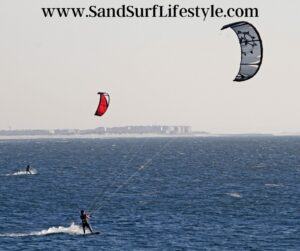
As with any sport, the equipment is the biggest expense but it can vary. Typically, it can cost between $2,000-4000. The reasons it varies so much are numerous. Like most things, the newer your equipment is, the more expensive it will be. While you can find some used equipment, it’s not always a good idea to get everything used. Some equipment, like safety equipment, is better obtained new. With used equipment, safety or otherwise, there’s always the risk that the equipment is defective and, in most cases, it’s almost impossible to get a refund. If you buy new equipment, you can get warranties to get them replaced or get your money back.
The large variation in costs happens for a couple of reasons. Kitesurfing equipment is made for different levels. The equipment made for people just getting into kitesurfing is less expensive than something made for people who want to kitesurf on a competitive level.
Another major reason for the wide variation in costs is the number of brands. Some brands are more expensive than others and some have a better reputation than others. Some brands are known for use by professional competitors and will cost more. While you may not have money for something top of the line, you also don’t want to aim for the cheapest equipment possible. If you want your equipment to be long-lasting and safe, you’ll need to spend money.
Some companies make kits that come with all the equipment but for those who want to purchase their equipment individually, let’s go over each piece.
Kites:
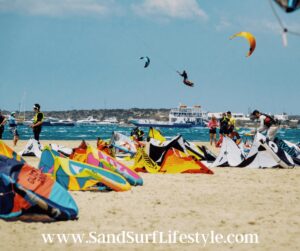 You can’t have kitesurfing without a kite. When buying your kite, you’ll have to consider where you’ll be surfing regularly. Some places have different wind conditions than others. Waves can be different too. If you only intend to go to one or two places, your kite doesn’t need to be as versatile. If you intend to do a lot of traveling and checking out a bunch of different spots, you’ll need a kite built for all conditions.
You can’t have kitesurfing without a kite. When buying your kite, you’ll have to consider where you’ll be surfing regularly. Some places have different wind conditions than others. Waves can be different too. If you only intend to go to one or two places, your kite doesn’t need to be as versatile. If you intend to do a lot of traveling and checking out a bunch of different spots, you’ll need a kite built for all conditions.
Another thing to consider is the materials. Most kites are made from polyester rather than nylon as some might think. The problem is that they can be subject to wear and tear if you don’t know how to pack them up correctly. Plus, they have to endure a lot of punishment. Some companies are trying to rectify this by blending polyester with other materials to make kites more durable. These newer kites are stronger but more expensive.
There are different types of kites too so when you shop, you should consider what you want to do.
A C-kite, so named for the shape it makes when laid out is powerful and not safe for beginners. They are too powerful unless you know what you’re doing so I’m going to skip that. The main types of kites you’ll be picking from are delta kites (forms a D-shape when open), the bow kite, and the hybrid.
A delta kite is good for people who like getting air and doing tricks. Though they can be used by people who like building up speed, the delta kite is most at home for people who like showing off to their friends or judges at competitions. In contrast, a bow kite is designed for speed. If you want to buy a racing kite, you might want this one. A hybrid kite is just what you’d think it is. It’s designed for both speed and air. The trouble is, hybrid kites can be more expensive. If you just want to free-ride I.E. relax not worry about doing tricks or going super-fast, all three kites serve that purpose.
Depending on various factors, a kite could cost between $400-$2000. Some people might be inclined to spend more to get an extra kite for different conditions which might be good if you intend to travel to different beaches. If you’re just starting or you only stick to one specific beach, it’s probably best to stick to having one kite.
You’ll also need a kite pump. These will help inflate your kite quickly. These can cost between $30-$100.
Kiteboards:
For the kite to be useful, they need the board. Like kites, different types of boards serve different purposes and people of different skill levels. Note that if you have a normal surfboard, it can’t take the place of an actual kiteboard nor can you use a kiteboard as a surfboard. Surfboards are not designed to go the high speeds kiteboards can go. Conversely, kiteboards are too heavy to take into the water without a kite.
Twin-tip boards:
As the name suggests, there are tips at the end of the board. These types are the most common and often the cheapest. Price aside, twin-tip boards are highly versatile and can be used for free-riding, racing, or doing tricks without much of a problem.
Is kitesurfing easier than surfing? Find out here.
Light wind boards:
Light wind boards are often used in areas where heavy wind isn’t always readily available though they do well enough in normal wind conditions. Another major benefit of light wind boards is that they are ideal for heavier kite surfers. However, as a drawback, they are more expensive.
 Kitesurf boards:
Kitesurf boards:
Kitesurf boards are a hybrid between surfboards and kiteboards. A kitesurf board is smaller and often has an epoxy core. That being the case, it’s still not a good idea to take these into the water without a kite.
Kitesurf boards are often used on the ocean waves to get big air and do tricks.
Foil boards:
Foil boards are among the fastest kiteboards out there because they are so light. Their weight makes it easier for them to turn. They’re also pretty expensive and not easy to use for beginners since they go at such high speeds and are often used on choppy waters and going upwind.
When shopping for kiteboards you can expect to pay between $300-$1000 depending on the type with foil boards being at the higher end.
Safety Equipment:
In terms of safety, kiteboarding has come a long way since it first took flight in the ’70s. With new equipment on the market, kitesurfing is one of the safer watersports. However, you will need to buy durable equipment. As you continue to learn the sport, you may not need some of it. Luckily, you may be able to exchange or sell beginner equipment.
Harnesses:
One of the first pieces of equipment you’ll need is a harness. These are usually made from the same material as wetsuits. Before you buy a harness, you should know your size.
A harness that doesn’t fit isn’t comfortable and more importantly, isn’t safe. Harnesses come in two main varieties. There are seated harnesses that are more useful for beginners. They don’t allow for much freedom of movement but they will help beginners get a feel for how to move in the wind and control their kiteboard. The waist harness is better used for people who have a better understanding of kiteboarding and their capabilities. Waist harnesses offer more freedom of movement but require more effort on the part of the user to control.
Harnesses can cost between $80-$200.
Control bars and lines:
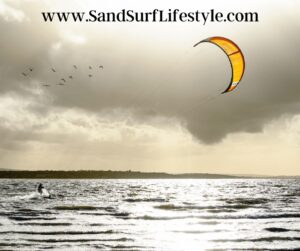 Your control bar is an important piece of equipment as it allows you to control your kite. The control bar will have space for kite lines. Most kites will come with spots for 2-5 lines. Be sure that you have enough lines to support your kite and a control bar with spaces for all the lines. If they are uneven, they can cause problems and make your kite difficult to steer.
Your control bar is an important piece of equipment as it allows you to control your kite. The control bar will have space for kite lines. Most kites will come with spots for 2-5 lines. Be sure that you have enough lines to support your kite and a control bar with spaces for all the lines. If they are uneven, they can cause problems and make your kite difficult to steer.
Control bars can cost between $200-$700. Kite lines can range between $20-100
Floatation vests and other equipment:
Even if you are a good swimmer, a floatation device is necessary. You never know when a wipeout may impair your ability to swim. Some beaches may require it. If you’re renting equipment, they may require you to have a vest. Many floatation vests are impact resistant and will help prevent injuries if you wipeout. These can cost between $90-$150. Other equipment like helmets, goggles, and gloves can add up to around $200.
Kitesurfing lessons
Lessons are essential for this sport. Some spots, such as areas with choppy water and other natural hazards or ones that draw large crowds, won’t let you onto the water if you aren’t certified. You’re learning to participate in a sport that involves you going at high speed. Many kitesurfers can get hurt. Even with up-to-date safety equipment, there are risks if you don’t know what you’re doing.
Your kitesurfing instructor should be certified by an organization like the International Kitesurfing Organization (though other ones are depending on your country). In your lessons, you’ll learn the basics of kitesurfing. You’ll also learn things like how to tell when the conditions in the wind and water are not safe to go kitesurfing and how to extricate yourself from a dangerous situation.
Kitesurfing lesson costs can change depending on how much instruction you need. Someone new to watersports will need more instruction than someone who already has experience doing things like surfing. If you can learn in a group, you can save money. Group lessons often cost between $30-$60 and it takes about 10 lessons to get certified (instructors can make exceptions if you have experience on the water). Private lessons cost more at $70-$100. You can save money if you take your lessons during the off-season.
One money-saving perk of lessons is that they will often let you rent equipment. The upside is that you can see if you like the sport before you put a bunch of money on equipment. The downside is that rentals are often first-come-first-serve.
Please note: This blog post is for educational purposes only and does not constitute legal or medical advice. Please consult a legal expert or medical professional to address your specific needs.

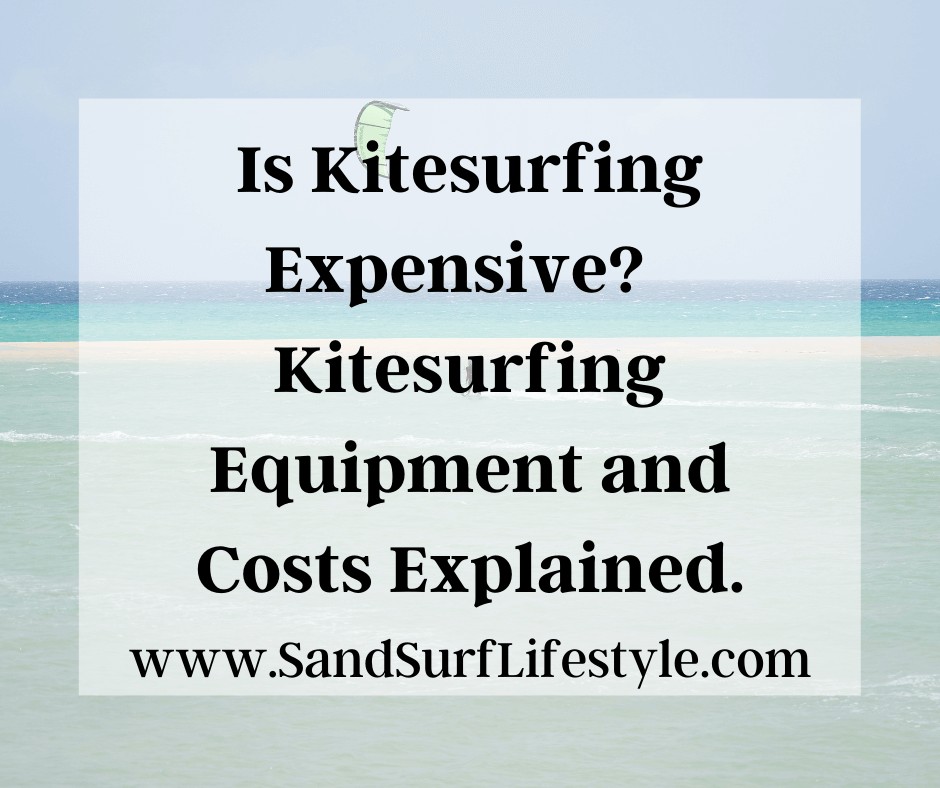
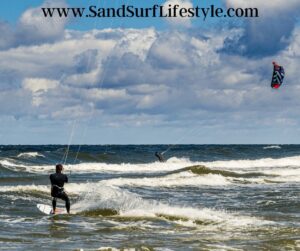 Kitesurf boards:
Kitesurf boards: